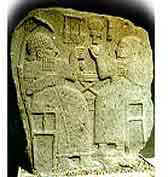

KAHRAMANMARAS
 City, southern Turkey, at the edge of a fertile plain below Ahir
Mountain, east-northeast of Adana. The city is near the southern outlet of three
important passes through the Taurus Mountains (from Göksun, Elbistan, and
Malatya).
City, southern Turkey, at the edge of a fertile plain below Ahir
Mountain, east-northeast of Adana. The city is near the southern outlet of three
important passes through the Taurus Mountains (from Göksun, Elbistan, and
Malatya).
Capital of the Hittite kingdom of Gurgum (c. 12th century BC), it was
known to the 8th-century-BC conquering Assyrians as Markasi and later to the
Romans as Germanicia Caesarea. The Arabs conquered it about AD 645 and used it
as a base for their incursions into Asia Minor. The town, destroyed several
times in the Arab-Byzantine-Armenian struggles, was rebuilt by the Umayyad
caliph Mu'awiyah I (7th century) and was fortified (c. 800) by the
'Abbasid caliph Harun ar-Rashid. It was briefly
occupied by the crusaders (1097) and passed on to the Seljuq Turks in the 12th
century. It was incorporated into the Ottoman Empire under Sultan Selim I in
about 1515. With the surrounding province, it was occupied by France in 1919 but
returned to Turkey two years later.
A medieval citadel that towers above the city contains an archaeological museum with a collection of Hittite monuments excavated nearby. The city has several mosques (notably the 15th-century Ulu Cami), medreses (religious schools), and old churches and is a centre of light industry and commerce, producing and exporting olive oil, spices, and handloomed goods. It is linked by a branch line with the Adana-Malatya railway.
The surrounding region is mountainous and contains rich mineral deposits,
chiefly iron and silver. The agricultural regions, watered by the Ceyhan River,
produce wheat, rice, and legumes. Pop. (1985) 210,371.
Known as "Markasi" in earliest ages, this city, 78 km north of Gaziantep, stands as a site of history, having a long past filled with numerous invasions, was once the capital of Gurgum, a Hittite State in the 12thcentury BC.
There exists an archaeological museum inside the citadel,
where Hittite sculptures are on display. Other important remains in the area are
the Ulu Mosque and the Tats Medrese, both dating back to the 15thcentury,
together with the Hatuniye and Beyazit Mosques of the Ottoman period.
the Ottoman period.
This province, the original name of which was Maras, had shown such velour during the War of Independence, that it was then given the title "Kahraman", which means of "hero".
The specialty of the region is its famous icecream well, and worth trying. Carved wooden furniture, copper and brass works and handworks of glided silver thread are also treasured. Caving, hunting, fishing beside plateaus and picnicking areas are also famous.
![]()
Home | Ana
Sayfa | All About Turkey | Turkiye
hakkindaki Hersey | Turkish Road Map
| Historical Places in Adiyaman | Historical
Places in Turkey | Mt.Nemrut | Slide
Shows | Related Links | Guest
Book | Disclaimer | Send a Postcard | Travelers' Stories | Donate a little to help | Getting Around Istanbul | Adiyaman Forum
|
|